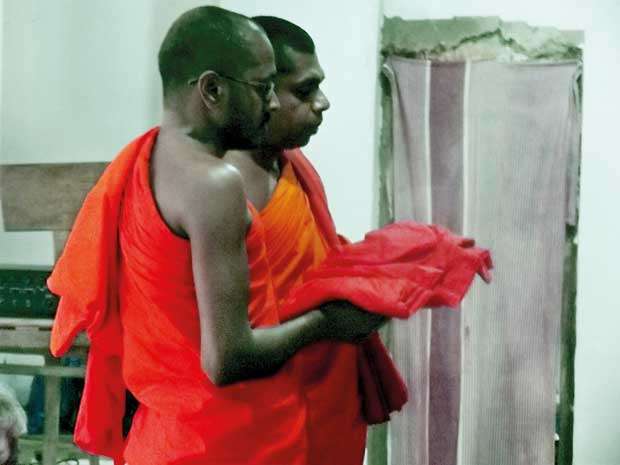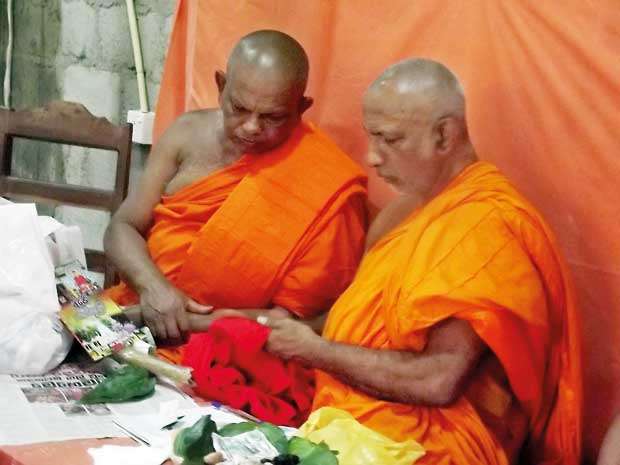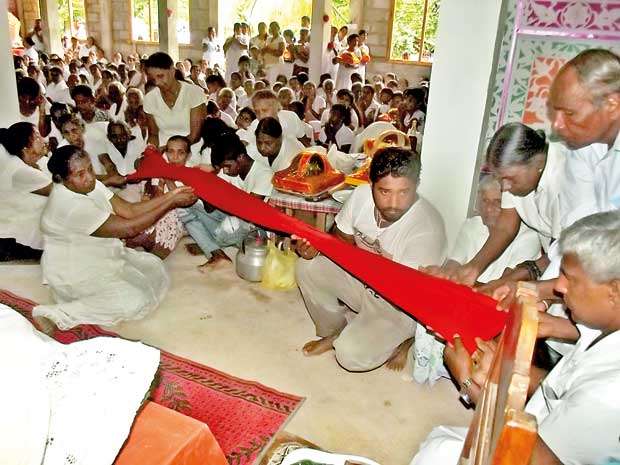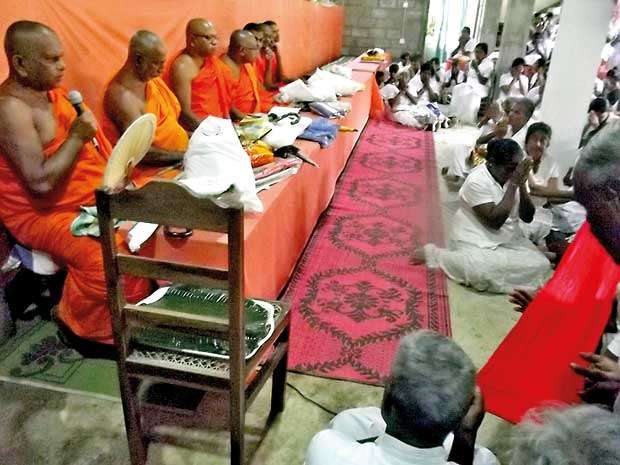21 Nov 2018 - {{hitsCtrl.values.hits}}

Two Senior monks offere the robe to the congregation of monks
 If you hear the throb of drums in the early hours of the morning during the period before Il Poya, then you can rest assured that the most important period of a monk is been brought to light by his followers. That then is the first indication that “the ritual of Katina” offering has commenced.
If you hear the throb of drums in the early hours of the morning during the period before Il Poya, then you can rest assured that the most important period of a monk is been brought to light by his followers. That then is the first indication that “the ritual of Katina” offering has commenced.
The greatest asset of a monk who had received Higher Ordination or Upasampada is the calling for ‘Vas’ during his life time.
The offering of “Katina Cheevaraya” is reported to have commenced during 6th BC in the time of Buddha while he was in Isipathnaramaya, Varanasi, India.
King Rajadhi Rajasinghe during the time of the Kandyan Kingdom offered ‘Katina Cheevara’ during his entire period of Kingship. So was King Parakramabahu VI of Kotte. It is considered the greatest asset to any man or woman who participates in the Katina ceremonies.
The cloth at that time was taken from cemeteries, where the practice was to leave the dead in forests. From these covered cloths of dead bodies, the cloth was brought, stitched and then made into a “Cheevaraya.”
So Devotees all over the country are preparing to offer the “Katina Cheevara” to the monks who have been in “Vas” to offer before ‘Il Poya.’ The observances began from Esala Poya. During this season the monks retreat to their temples or in the early days to forest caves to meditate, in areas where devotees were living to preach the Dhamma of Buddha for their way of life and deliverance. At Aluvihare Vihare some of the cave abodes could be seen to this day and they are in good condition.

In temples during this period devotees had arranged with the monks to listen to sermons, sometimes daily in the evenings. From last Poya day, devotees in the villages or urban communities are preparing to offer the “Katina Cheevara” before ‘Il Poya” to the monks who have been in ‘Vas’ during the last three months. Yet only one ‘Katina Cheevaraya’ or robe could be offered at one temple, even if there are a number of monks who have been in ‘Vas’ during the season. The offering of the robe is by the devotees, but who should be offered the robe is the decision of the congregation of monks.
Professor Mohan Wijeratne in his Book on Buddha gives Katina as ‘hard’ like a diamond.. How did ‘Vas’ originate. It began with five monks who were on their way to meet Gauthama Buddha and just sixty kilometers away, they met with the hard rains.They then spent their time meditating and ‘living together’. After the rains they set about their objective to meet the Buddha and told him of their experiences and by traveling in the rain, they would be trampling other lives, both plant and animals.
Buddha then instructed that they should refrain from traveling about during the rainy season and meditate. He also said that whenever it is possible to address the devotees for their deliverance. Then there were groups who were antagonistic to Buddha who criticized the travel of his disciples during the rainy season. This also led to instruct monks that during the rainy season they should curtail their movements. With this, Buddha advised all monks to perform ‘Vas’ during the rainy season On the other hand the monks who had observed ‘Vas’ prepare with the devotees for the offering of the ‘Katina’ robe. Should a monk fail to observe ‘Vas’ on Esala Poya, then he is entitled to observe ‘Pasu Vas’, a day after ‘Nikini’ poya, provided he retreats to the ‘Poyage’ or the area which is reserved for monks to hold their ceremonies and meetings.
Offering of the ‘Katina robe’ is one, out of the eight meritorious acts that have been declared by Buddha.
I set about to a small village on the outskirts of the Hantane range just a few days before Il poya to find out how the ritual is been enacted.

Offering of the Katina Cheevaraya by the devotees
The temple was full of villagers in their best for the occasion and everyone of them were with an “Atapirikara” to be offered to the monks who have been in retreat or ‘Vas’ After the cloth for the processing of the “Katina Cheevaraya” is brought from the place it had been kept overnight, it is then cut according to a plan set about by Buddha. The ‘Katina Cheevaraya’ is according to the plan of paddy fields of king Bimbisara. But, the cloth at that time was taken from cemeteries, where the practice was to leave the dead in forests. From these covered cloths of dead bodies, the cloth was brought, stitched and then made into a “Cheevaraya.”
After the “Cheevaraya” was stitched, it is dyed in a “pandu oruwa” or a receptacle made out of a log for the specific purpose of dying the “Cheevaraya.”
After the Cheevaraya or robe is dried it is brought with all the pomp and ceremony into the area where it is offered to the monks who have assembled to appoint a monk to receive the “Katina Cheevaraya.”
The greatest asset of a monk who had received Higher Ordination or Upasampada is the calling for ‘Vas’ during his life time
The Katina Cheevarya is then offered to the monks by the devotees by holding the open robe.
This then does not mean that the Katina Cheevara should be offered to the very monk who had observed “Vas” or Retreat during the period. After the “Cheevaraya” or robe is offered to the monks, then it is their duty to select a monk from the congregation or even from outside to offer the “Katina Cheevaraya.”
Once the “Katina Cheevaraya” is in the hands of the monks in congregation, then the final ceremony commences for the offering of the “Katina robe.”

The robe is then held by two Senior monks and then again it is offered to the congregation of monks. They in turn discuss as to whom the ‘Cheevaraya ‘ should be offered. After their decision, the monk in question is offered the robe by the most senior monk, to the recipient.
The recipient monk, then goes through a process, and in his stanzas he says that the Cheevaraya would be with him and he will touch it daily and be the third robe, as allowed by Buddha.
The robe is then marked by him with a key, having kept a betel leaf over the key so that a mark would be left to recognise the “ Katina Cheevaraya “ over the other robes.
Thus then ends the Katina offering.
30 Nov 2024 3 hours ago
30 Nov 2024 4 hours ago
30 Nov 2024 4 hours ago
30 Nov 2024 6 hours ago
30 Nov 2024 9 hours ago